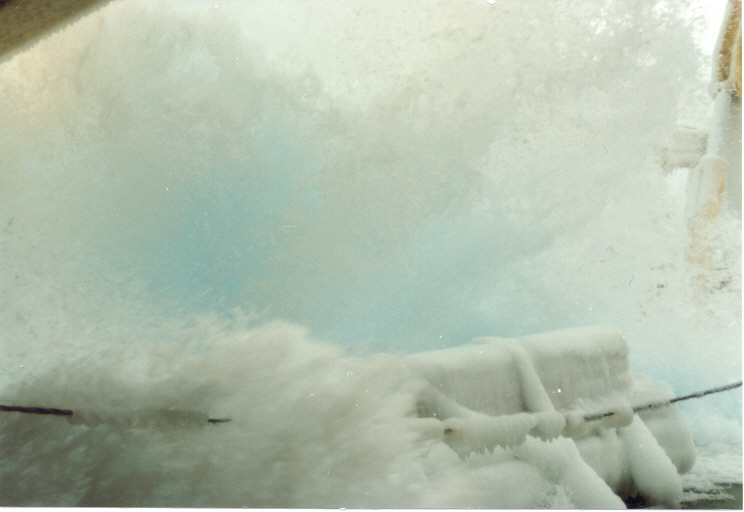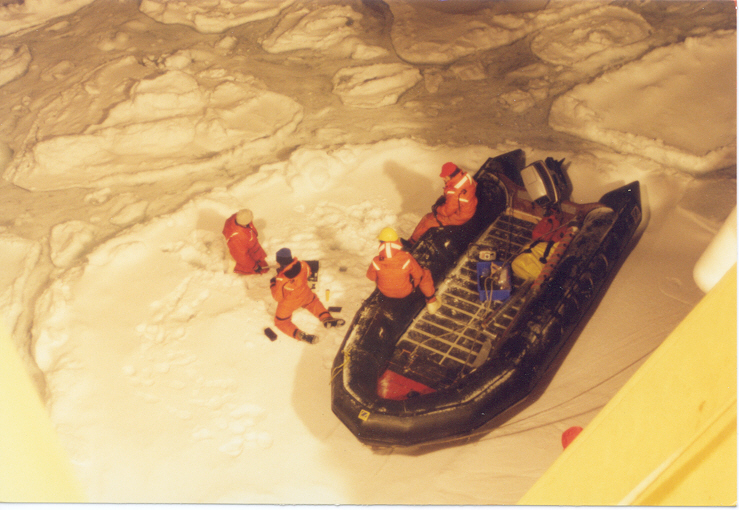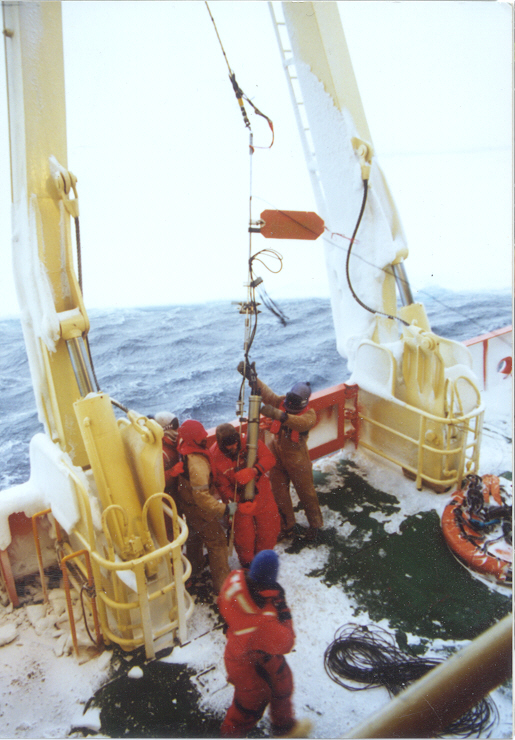Antarctic Zone Flux Experiment (ANZFLUX)
Location and Duration
Drift Stations from the NSF research vessel Nathaniel B Palmer near
Maud Rise, Antarctica
1 Jul 1994 to 31 Aug 1994 (Representative photographs here)
Background
Measurements made during the Ice Station Weddell drift in 1991-92 illustrated similar upper ocean response under multiyear ice in both hemispheres. There remained, however, the basic question of why ice-ocean heat transfer over much of the Southern Ocean was an order of magnitude larger than in the Arctic. We knew that stratification there was much weaker than in the Arctic Ocean, presenting less barrier to upward heat flux, but there was also the question of whether deep convection in the Antarctic zone of the Southern Ocean could provide a direct conduit between surface and abyssal waters. There are very few places in the world where vertical density stratification is anywhere near weak enough to allow such deep convection. During several winters in the early 1970s, satellite imagery had shown a large region of open water or low concentration sea ice near Maud Rise in the Atlantic Sector of the Antarctic seasonal ice pack. This feature, dubbed the Weddell Polynya, occurred well within the normal confines of winter ice, indicating strong upward heat convection. From summer ocean measurements made in the same region, A. Gordon found evidence of a "chimney" of water with uniform temperature and salinity characteristics extending to great depth, indicating that deep convection had occurred during the previous winter, perhaps associated with the Polynya.
The Antarctic Zone program that Gordon had initiated to sponsor the US/Soviet Ice Station Weddell project brought together ocean scientists who had traditionally worked at one pole or the other. Based on our success with upper ocean physics measurements during ISW, I worked with Doug Martinson at Lamont-Doherty Environmental Observatory to propose a winter project from the R/V Nathaniel B Palmer that would measure directly how the upper ocean near Maud Rise responded to surface forcing from frequent winter storms traversing the region. We titled the program the Antarctic Zone Flux Experiment (ANZFLUX), and assembled a skilled team with enough experience to make meaningful atmospheric/ice/ocean measurements under the extreme conditions we would encounter in austral winter.
Narrative
We assembled in Punta Arenas, Chile, on the Strait of Magellan late in June to
sort through tons of gear readying for departure. For many us who had worked mostly in the Arctic, it was
the first experience with the Office of Polar Programs Antarctic
operations, which breaks the project into three distinct groups:
the officers and crew from Edison-Choest run the ship, which is on charter
to NSF; Antarctic Support Associates provides logistics including
shipping, travel, onboard standard science support; and finally the
science party comprising in our case teams headed by seven principal investigators. I
was chief scientist. On the night before sailing a number of us gathered
in the main square at a majestic statue of Ferdinand Magellan. Keeping
with custom we rubbed a well polished toe for good luck.

We sailed on 27 Jun 1994 headed east across the Scotia Sea under benign weather, a rarity in the winter Southern Ocean, headed to an ice entry point at about 67ºS 20ºW. We were making good time, and anticipated moving ahead of schedule, when I got a phone call in the CS cabin at about 5 am on 2 July asking me to come to the engine room. There I learned that a cylinder on one of the four diesel engines had blown a ring, and that we could not enter the ice without all engines in good order. Normally the crew would have had parts to replace the ring, but they took pains to show me that what they thought to be the replacement part had been packaged wrong.
Consequently we needed to sail back to Punta Arenas, where the
Caterpillar mechanic would be waiting on the dock. By this time the
weather had reverted to normal, and we were in pretty heavy seas for the
long trip into port and then back, reducing our project science time by
five days. We finally arrived at the ice edge  at 57ºS 10ºW on 14
Jul after passing the So. Sandwich Islands, a series of volcanoes looking
like something out of Twenty Thousand Leagues Under the Sea.
at 57ºS 10ºW on 14
Jul after passing the So. Sandwich Islands, a series of volcanoes looking
like something out of Twenty Thousand Leagues Under the Sea.
Storms we had encountered on the second crossing left a broad marginal
ice zone. We stopped for some sampling on individual pancakes, then
continued on a linear path toward our first drift site in the warm
regime (Tmax>1ºC), making conductivity-temperature-depth
(CTD) stations along the way. 
Upon entering the warm regime, we conducted a CTD survey as a cross with 300 km legs centered on the site we had chosen for the first drift. On completing the survey, we located a suitible floe and began deploying four "helo huts" and accompanying instrumention away from the ship. Right on cue, soon after the camp was established, our first storm materialized. Here I will quote from the situation report that I filed by email with our program manager at NSF every Monday:
Yesterday was a blur of blowing snow in winds with gusts to 50 kt and ice drift speeds as high as 75 cm/s. I think it fair to say that we are all rather awed by the oceanic response to this event. On Saturday, when winds were calm and ice drift slow, there was rapid freezing: unprotected hydroholes were growing several centimeters of ice in a few hours, and the ocean mixed layer was near its freezing temperature. This morning the mixed layer temperature is 0.3º above freezing! By Saturday afternoon, previously frozen hydroholes were clear and the mixing shown by our instruments very intense. Clearly we were undergoing a massive upward mixing event. Very exciting science, especially when combined with moving shelters, deploying instruments, and operating off ship in full gale conditions.
After a brief lull, we were hit by a second storm with similar results.
We were actually somewhat worried that the ice, which was only half a meter
thick to begin with, might melt from underneath us. Instead it does what sea
ice often does: split. After supper during the second day of the second
storm we saw a crack appear in the floe between the ship and most of the
on-ice station. This quickly escalated into a full fledged breakup,
requiring quick action to rescue gear adjacent to the ship, including
snowmobiles. When the ice appeared to stabilize, we mounted a reconnaissance
to check the far huts, finding that a small crack under two of the huts. A
group was organized to move the huts to safer ice, and operation
accomplished around midnight when stronger winds and decreasing visibility
(even in the Palmers searchlights) forced everyone back aboard. Hopes that
things would stabilize enough to resituate the camp the next day were dashed
about 5 am by formation of a pressure ridge at an another lead that had
opened earlier.

We decided to abandon the site and began an intense recovery effort. My project had a particular problem. I had deployed a mast with six turbulence instrument clusters (TICs), spaced at 2-m intervals capable of being lowered down to 100 m depth. This required a derrick and winch arrangement housed in an "outhouse" shaped shelter. Typically the mast was assembled in 2-m segments with the derrick height chosen so that each TIC would be attached just above the surface of the hydrohole. Cables from each TIC were fed to a highly modifed Sea-Bird Electronics CTD, mounted near the center of the mast. The problem was that enough snow had gathered in the lee of the ship during the storm to depress the ice freeboard in the vicinity of mast installation so that the level at which we could remove the instruments from the mast entailed unhooking cable and unbolting other connectors, was now below the surface so we worked barehanded in water at -1.8 ºC. Tom Lehman and I would take turns, one working in the water while the other tried to return feeling to his hands by holding them at the outlet of the "salamander" kerosene space heater. Needless to say, with a brisk wind and air temperature well below zero it was an ordeal. Eventually, we got all the equipment aboard and recovered, and the camp cleaned up by supper time.
One of the joys of being CS is that after you have been going full steam for about 36 hours, had supper, and would like nothing better than to crawl into your bunk, the captain looks at you and says, "Where to, Doc?" Decisions had to be made, so we held a PI meeting to discuss our options. Despite my momentarily following asleep standing at the whiteboard, we agreed on establishing a second camp to the east of our location, over the summit of the Maud Rise seamount near where the Weddell Polynya had originated. I delivered our new target coordinates to Captain Joe, then found my bunk.
The next day dawned clear and calm. We deployed buoys to track
conditions near our first station remotely, then sailed toward the new location.
 Although the Maud Rise drift
was deployed with some trepidation because we were unable to find ice
thicker than about 30-40 cm, the camp survived its planned duration
uneventfully and was recovered on 8 August. In general, winds and
ice drift were less extreme than the earlier drift, yet values were
still quite energetic compared with previous experience.
Camp evacuation was much more orderly, and we all marveled at
an Adelie penguin, who supervised the affair by purposely walking from one
site to the next as if issuing instructions. In general, we all enjoyed the
penguins (mostly female Emporors) who apparently ignored the NSF directive to avoid contact, by often coming up
close to observe our curious activities.
Although the Maud Rise drift
was deployed with some trepidation because we were unable to find ice
thicker than about 30-40 cm, the camp survived its planned duration
uneventfully and was recovered on 8 August. In general, winds and
ice drift were less extreme than the earlier drift, yet values were
still quite energetic compared with previous experience.
Camp evacuation was much more orderly, and we all marveled at
an Adelie penguin, who supervised the affair by purposely walking from one
site to the next as if issuing instructions. In general, we all enjoyed the
penguins (mostly female Emporors) who apparently ignored the NSF directive to avoid contact, by often coming up
close to observe our curious activities.
After completion of the second drift, our plan was to proceed
west-northwest in the "cold regime" outflow part of the Weddell Gyre, where
Tmax is considerably less than farther south. On 11
August, on the transect to the cold
regime drift site, we encountered a very intense cyclone, with winds
briefly reaching hurricane force (65 kt). We stopped for a CTD/ice properties station, and that night, lying in my bunk
listening to the wind, I thought about the challenge of measuring turbulent
fluxes in the upper ocean during a near hurricane, something no one had
thought possible. In the morning, I broached the subject with the bridge,
who were accommodating, and by mid-day
 with the ship snugged up against the ice, a flux measuring instrument
cluster was deployed over the side, with a two-hour turbulence record from
mid-depth in the 100-m thick mixed layer. It was a team effort, with
several of us holding the instruments and ourselves against a wind that
made standing on deck a struggle. It was eerie operating from a ship in
winds that high, yet with no discernible vertical platform motion.
with the ship snugged up against the ice, a flux measuring instrument
cluster was deployed over the side, with a two-hour turbulence record from
mid-depth in the 100-m thick mixed layer. It was a team effort, with
several of us holding the instruments and ourselves against a wind that
made standing on deck a struggle. It was eerie operating from a ship in
winds that high, yet with no discernible vertical platform motion.
The big storm proved to be the undoing of the cold regime drift as the ship's headway fell to 3-4 knots and fuel consumption increased dramatically. To maintain enough fuel reserve to safely exit the ice, the third drift was curtailed to an extended (6 h) station, during which several of the ice camp systems were deployed directly from the ship. After that, we made for Punta Arenas, arriving on 24 August.
Results
ANZFLUX was extremely productive. By direct measurement, we confirmed that winter heat flux from the ice-covered Southern Ocean was an order of magnitude greater than in the Arctic. We also established that the heat loss was a cyclical process acting like a "thermal flywheel." Between storms, large thermal gradients in the relatively thin ice would grow ice rapidly. During these times mixed layer temperature would have cooled to slightly above freezing (~0.08 K). Then one of the ubiquitous cyclones of the Southern Ocean would blow in. Since the ice was thin and weak, the wind stress would be passed to the water column with little change, and strong mixing at the interface between the mixed layer (about 100 m thick) and warmer water below would bring heat up, enough to melt most or all of the ice that had formed in the previous lull. In this way, the ice that formed early in the winter to a thickness of half a meter or less, would grow little over most of the remainder of the winter, despite consistent cold temperatures.
In addition, we were sucessful at measuring turbulent fluxes under broad ranges of both stress and temperature elevation of near surface water. This provided robust estimates of two critical parameters necessary for understanding ice-ocean exchanges: the ice undersurface hydraulic roughness, and the turbulent heat exchange coefficient.
McPhee, M. G., C. Kottmeier, J.H. Morison, 1999, Ocean heat flux in the central Weddell Sea in winter, J. Phys.Oceanogr., 29, 1166-1179.
McPhee M. G., S. F. Ackley, P. Guest, B. A. Huber, D. G. Martinson, J. H. Morison, R. D. Muench, L. Padman, and T. P. Stanton, 1996. The Antarctic Zone Flux Experiment , Bull. Am. Met. Soc., 77, 1221-1232.